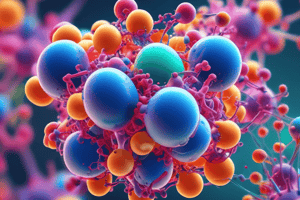Podcast
Questions and Answers
What is osmotic pressure defined as?
What is osmotic pressure defined as?
- The pressure required to offset the movement of solvent through a semipermeable membrane (correct)
- The temperature at which osmosis occurs
- The pressure exerted by a pure solvent
- The pressure needed to promote osmosis in a solution
Surfactants are also known as surface-active agents.
Surfactants are also known as surface-active agents.
True (A)
What phenomenon is used to describe the ability of colloidal particles to scatter light?
What phenomenon is used to describe the ability of colloidal particles to scatter light?
Faraday-Tyndall effect
The difference between the actual surface of a particle and the electroneutral region of the dispersion is known as the ______ potential.
The difference between the actual surface of a particle and the electroneutral region of the dispersion is known as the ______ potential.
Match the following types of flow with their characteristics:
Match the following types of flow with their characteristics:
Which method is NOT used for determining particle size?
Which method is NOT used for determining particle size?
Brownian movement is the random motion of larger particles suspended in a fluid.
Brownian movement is the random motion of larger particles suspended in a fluid.
What are the two key properties of powders important for granulation?
What are the two key properties of powders important for granulation?
What is the energy range of intermolecular forces between two polar molecules?
What is the energy range of intermolecular forces between two polar molecules?
Cohesion refers to the attraction between different molecules.
Cohesion refers to the attraction between different molecules.
What type of intermolecular force exists between a polar and a non-polar molecule?
What type of intermolecular force exists between a polar and a non-polar molecule?
A mixture that forms a homogenous dispersion with a particle size less than ______ is considered a true solution.
A mixture that forms a homogenous dispersion with a particle size less than ______ is considered a true solution.
Match the following types of solutions with their characteristics:
Match the following types of solutions with their characteristics:
Boiling point elevation occurs when a non-volatile solute is added to a volatile solvent.
Boiling point elevation occurs when a non-volatile solute is added to a volatile solvent.
What happens to the vapor pressure of a solvent when a non-volatile solute is added?
What happens to the vapor pressure of a solvent when a non-volatile solute is added?
Which of the following is NOT a colligative property of solutions?
Which of the following is NOT a colligative property of solutions?
Flashcards are hidden until you start studying
Study Notes
Attractive Forces in Molecules
- Intramolecular Forces: Involve electron sharing; can be polar (unequal sharing creates partial charges) or non-polar (equal sharing).
- Polar molecules exhibit affinity between oppositely charged particles and can involve electron transfer.
- Intermolecular Forces (IMFAs):
- Energy ranges from 0.5 to 7 kcal/mole depending on interactions:
- Polar-polar: 1-7 kcal/mole
- Polar-nonpolar: 1-3 kcal/mole
- Nonpolar-nonpolar: 0.5-1 kcal/mole
- Energy ranges from 0.5 to 7 kcal/mole depending on interactions:
- Cohesion vs Adhesion:
- Cohesion: attraction among similar molecules.
- Adhesion: attraction among different molecules.
States of Matter
- Plasma State: Supercritical fluid state, intermediary between liquid and gas.
- Liquid State:
- Dispersed systems classified into three categories based on particle size:
- Homogenous molecular dispersion (< 1 nm).
- Intermediate systems (1 nm – 0.5 µm).
- Coarse dispersions (> 0.5 µm), includes emulsions and suspensions.
- Dispersed systems classified into three categories based on particle size:
USP Terms of Solubility
- Colligative Properties of Solutions:
- Vapor Pressure Lowering: Non-volatile solute addition reduces solvent vapor pressure based on solute concentration.
- Boiling Point Elevation: Non-volatile solutes elevate boiling point above that of pure solvent due to lowered vapor pressure.
- Freezing Point Depression: Solutions have lower freezing points compared to pure solvents.
- Osmotic Pressure: Solutions exert higher osmotic pressure than pure solvents, defined as the pressure to prevent osmosis through a semipermeable membrane.
Interfacial Phenomenon
- Related to molecules at phase boundaries.
- Interfacial Tension: Occurs in liquid-liquid systems.
- Surface Tension: Present in solid-liquid and liquid-gas systems.
- Surfactants: Also known as surface-active agents, alter surface and interfacial tensions.
Colloidal Dispersions
- Properties of Colloids:
- Optical: Exhibits the Faraday-Tyndall effect, which scatters light (e.g., fog).
- Kinetic: Brownian movement, where particles appear as moving light points; diffusion balances concentration.
- Electric:
- Nernst Potential: Potential difference between particle surfaces and surrounding neutral regions.
- Zeta Potential: Difference in potential impacting pharmaceutical applications.
Coarse Dispersion
- Stability issues present challenges in formulation.
Rheology
- Viscosity (ƞ): Resistance to flow, characterized by multiple classes:
- Absolute, Kinematic, Relative viscosity distinctions.
- Viscometers: Instruments used to measure viscosity.
- Flow Systems:
- Newtonian Flow: Consistent viscosity regardless of shear rate.
- Non-Newtonian Flow: Viscosity varies with shear rate:
- Shear-dependent: Plastic, Pseudoplastic, Dilatant.
- Time-dependent: Thixotropy, Rheopexy.
Micromeritics
- Particle Size Determination Methods:
- Optical Microscopy, Sieve Analysis, Sedimentation Method, Automatic Particle Counters (Coulter, HIAC/Royco, Gelman).
- Particle Volume: Total space occupied by powder calculated as Vb = Vp + intra + inter-spaces.
- Particle Density: Measure of mass per unit volume.
- Porosity (ϵ): Total voids/spaces in particles.
- Properties for Granulation:
- Fluidity: Ability of powder to flow.
- Compressibility: Capacity to reduce volume under pressure.
Studying That Suits You
Use AI to generate personalized quizzes and flashcards to suit your learning preferences.





